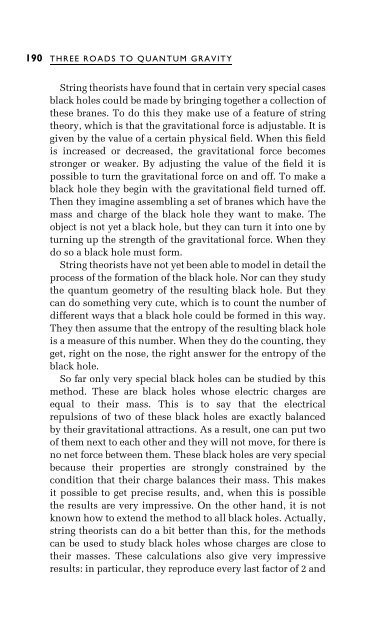Three Roads To Quantum Gravity
Three Roads To Quantum Gravity
Three Roads To Quantum Gravity
Create successful ePaper yourself
Turn your PDF publications into a flip-book with our unique Google optimized e-Paper software.
190 THREE ROADS TO QUANTUM GRAVITY<br />
String theorists have found that in certain very special cases<br />
black holes could be made by bringing together a collection of<br />
these branes. <strong>To</strong> do this they make use of a feature of string<br />
theory, which is that the gravitational force is adjustable. It is<br />
given by the value of a certain physical ®eld. When this ®eld<br />
is increased or decreased, the gravitational force becomes<br />
stronger or weaker. By adjusting the value of the ®eld it is<br />
possible to turn the gravitational force on and off. <strong>To</strong> make a<br />
black hole they begin with the gravitational ®eld turned off.<br />
Then they imagine assembling a set of branes which have the<br />
mass and charge of the black hole they want to make. The<br />
object is not yet a black hole, but they can turn it into one by<br />
turning up the strength of the gravitational force. When they<br />
do so a black hole must form.<br />
String theorists have not yet been able to model in detail the<br />
process of the formation of the black hole. Nor can they study<br />
the quantum geometry of the resulting black hole. But they<br />
can do something very cute, which is to count the number of<br />
different ways that a black hole could be formed in this way.<br />
They then assume that the entropy of the resulting black hole<br />
is a measure of this number. When they do the counting, they<br />
get, right on the nose, the right answer for the entropy of the<br />
black hole.<br />
So far only very special black holes can be studied by this<br />
method. These are black holes whose electric charges are<br />
equal to their mass. This is to say that the electrical<br />
repulsions of two of these black holes are exactly balanced<br />
by their gravitational attractions. As a result, one can put two<br />
of them next to each other and they will not move, for there is<br />
no net force between them. These black holes are very special<br />
because their properties are strongly constrained by the<br />
condition that their charge balances their mass. This makes<br />
it possible to get precise results, and, when this is possible<br />
the results are very impressive. On the other hand, it is not<br />
known how to extend the method to all black holes. Actually,<br />
string theorists can do a bit better than this, for the methods<br />
can be used to study black holes whose charges are close to<br />
their masses. These calculations also give very impressive<br />
results: in particular, they reproduce every last factor of 2 and



![arXiv:1001.0993v1 [hep-ph] 6 Jan 2010](https://img.yumpu.com/51282177/1/190x245/arxiv10010993v1-hep-ph-6-jan-2010.jpg?quality=85)


![arXiv:1008.3907v2 [astro-ph.CO] 1 Nov 2011](https://img.yumpu.com/48909562/1/190x245/arxiv10083907v2-astro-phco-1-nov-2011.jpg?quality=85)








![arXiv:1002.4928v1 [gr-qc] 26 Feb 2010](https://img.yumpu.com/41209516/1/190x245/arxiv10024928v1-gr-qc-26-feb-2010.jpg?quality=85)
![arXiv:1206.2653v1 [astro-ph.CO] 12 Jun 2012](https://img.yumpu.com/39510078/1/190x245/arxiv12062653v1-astro-phco-12-jun-2012.jpg?quality=85)
